2016 RENAULT GRAND SCENIC remove seats
[x] Cancel search: remove seatsPage 25 of 270
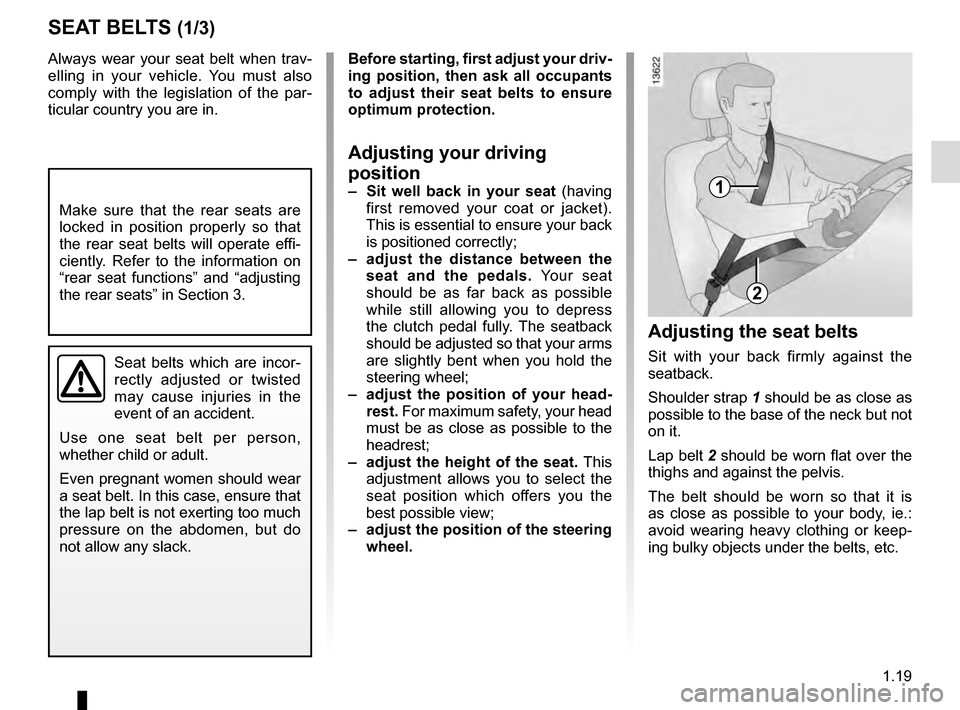
1.19
Always wear your seat belt when trav-
elling in your vehicle. You must also
comply with the legislation of the par-
ticular country you are in.
SEAT BELTS (1/3)
Make sure that the rear seats are
locked in position properly so that
the rear seat belts will operate effi-
ciently. Refer to the information on
“rear seat functions” and “adjusting
the rear seats” in Section 3.
Seat belts which are incor-
rectly adjusted or twisted
may cause injuries in the
event of an accident.
Use one seat belt per person,
whether child or adult.
Even pregnant women should wear
a seat belt. In this case, ensure that
the lap belt is not exerting too much
pressure on the abdomen, but do
not allow any slack.
Before starting, first adjust your driv-
ing position, then ask all occupants
to adjust their seat belts to ensure
optimum protection.
Adjusting your driving
position
– Sit well back in your seat (having
first removed your coat or jacket).
This is essential to ensure your back
is positioned correctly;
– adjust the distance between the seat and the pedals. Your seat
should be as far back as possible
while still allowing you to depress
the clutch pedal fully. The seatback
should be adjusted so that your arms
are slightly bent when you hold the
steering wheel;
– adjust the position of your head- rest. For maximum safety, your head
must be as close as possible to the
headrest;
– adjust the height of the seat. This
adjustment allows you to select the
seat position which offers you the
best possible view;
– adjust the position of the steering
wheel.
Adjusting the seat belts
Sit with your back firmly against the
seatback.
Shoulder strap 1 should be as close as
possible to the base of the neck but not
on it.
Lap belt 2 should be worn flat over the
thighs and against the pelvis.
The belt should be worn so that it is
as close as possible to your body, ie.:
avoid wearing heavy clothing or keep-
ing bulky objects under the belts, etc.
1
2
Page 41 of 270
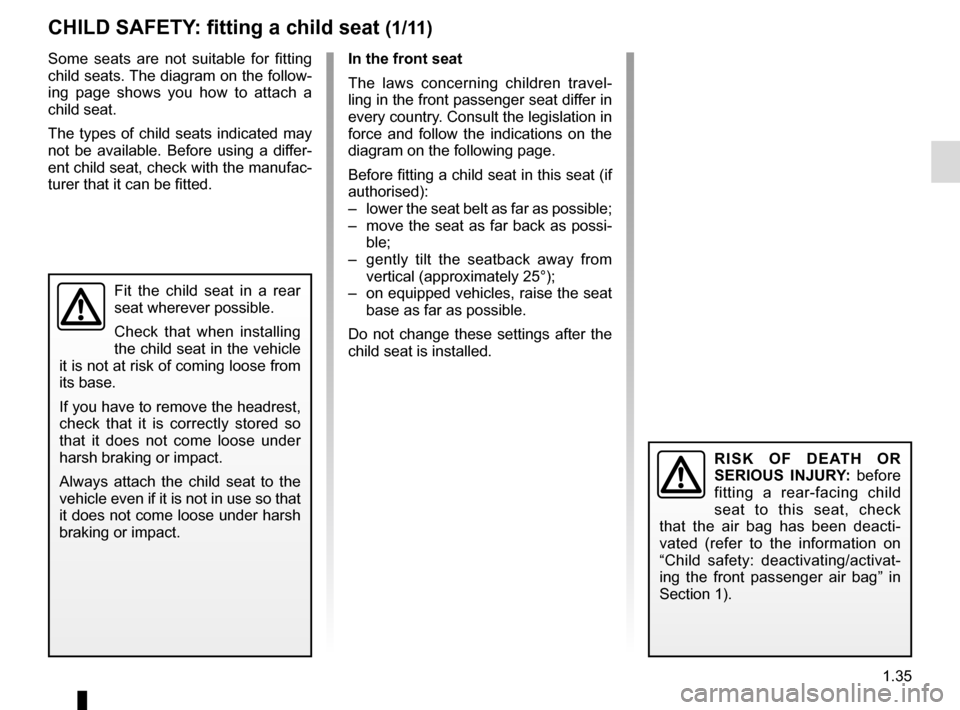
1.35
CHILD SAFETY: fitting a child seat (1/11)
In the front seat
The laws concerning children travel-
ling in the front passenger seat differ in
every country. Consult the legislation in
force and follow the indications on the
diagram on the following page.
Before fitting a child seat in this seat (if
authorised):
– lower the seat belt as far as possible;
– move the seat as far back as possi-ble;
– gently tilt the seatback away from vertical (approximately 25°);
– on equipped vehicles, raise the seat base as far as possible.
Do not change these settings after the
child seat is installed.
Some seats are not suitable for fitting
child seats. The diagram on the follow-
ing page shows you how to attach a
child seat.
The types of child seats indicated may
not be available. Before using a differ-
ent child seat, check with the manufac-
turer that it can be fitted.
Fit the child seat in a rear
seat wherever possible.
Check that when installing
the child seat in the vehicle
it is not at risk of coming loose from
its base.
If you have to remove the headrest,
check that it is correctly stored so
that it does not come loose under
harsh braking or impact.
Always attach the child seat to the
vehicle even if it is not in use so that
it does not come loose under harsh
braking or impact.
RISK OF DEATH OR
SERIOUS INJURY: before
fitting a rear-facing child
seat to this seat, check
that the air bag has been deacti-
vated (refer to the information on
“Child safety: deactivating/activat-
ing the front passenger air bag” in
Section 1).
Page 44 of 270
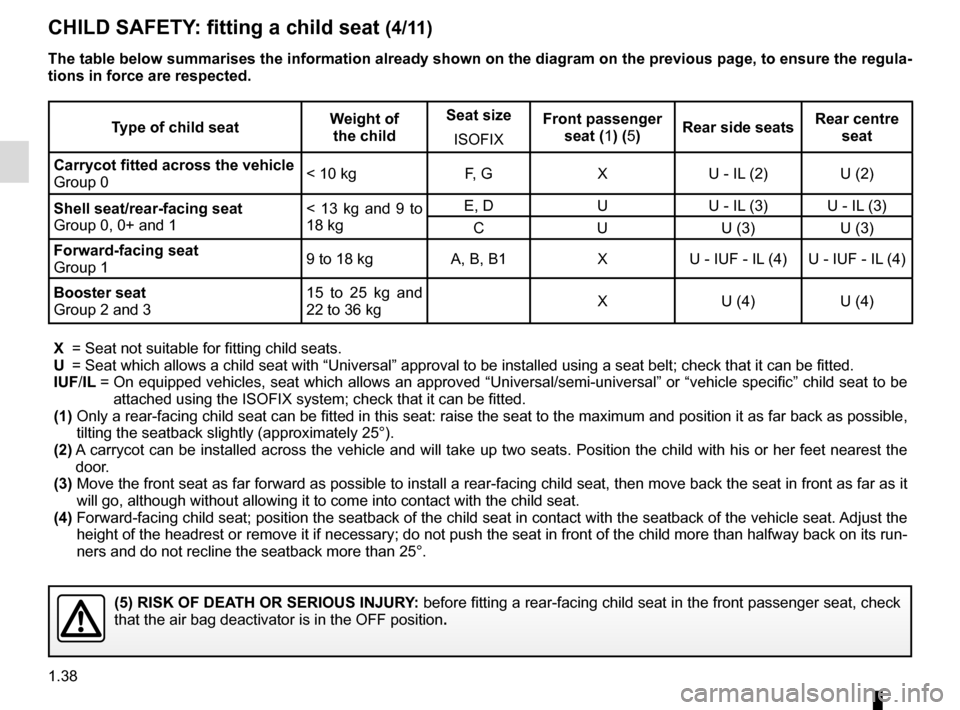
1.38
CHILD SAFETY: fitting a child seat (4/11)
Type of child seatWeight of
the child Seat size
ISOFIX Front passenger
seat (1) (5) Rear side seats Rear centre
seat
Carrycot fitted across the vehicle
Group 0 < 10 kg F, G X U - IL (2) U (2)
Shell seat/rear-facing seat
Group 0, 0+ and 1 < 13 kg and 9 to
18 kgE, D U U - IL (3) U - IL (3)
C U U (3) U (3)
Forward-facing seat
Group 1 9 to 18 kg A, B, B1 X U - IUF - IL (4) U - IUF - IL (4)
Booster seat
Group 2 and 3 15 to 25 kg and
22 to 36 kg
X U (4) U (4)
X = Seat not suitable for fitting child seats.
U = Seat which allows a child seat with “Universal” approval to be ins\
talled using a seat belt; check that it can be fitted.
IUF/IL = On equipped vehicles, seat which allows an approved “Universal/semi-u\
niversal” or “vehicle specific” child seat to be
attached using the ISOFIX system; check that it can be fitted.
(1) Only a rear-facing child seat can be fitted in this seat: raise the seat\
to the maximum and position it as far back as possible ,
tilting the seatback slightly (approximately 25°).
(2) A carrycot can be installed across the vehicle and will take up two seats\
. Position the child with his or her feet nearest the
door.
(3) Move the front seat as far forward as possible to install a rear-facing \
child seat, then move back the seat in front as far as it
will go, although without allowing it to come into contact with the chil\
d seat.
(4) Forward-facing child seat; position the seatback of the child seat in co\
ntact with the seatback of the vehicle seat. Adjust the
height of the headrest or remove it if necessary; do not push the seat i\
n front of the child more than halfway back on its run-
ners and do not recline the seatback more than 25°.
(5) RISK OF DEATH OR SERIOUS INJURY: before fitting a rear-facing child seat in the front passenger seat, ch\
eck
that the air bag deactivator is in the OFF position .
The table below summarises the information already shown on the diagram \
on the previous page, to ensure the regula-
tions in force are respected.
Page 46 of 270
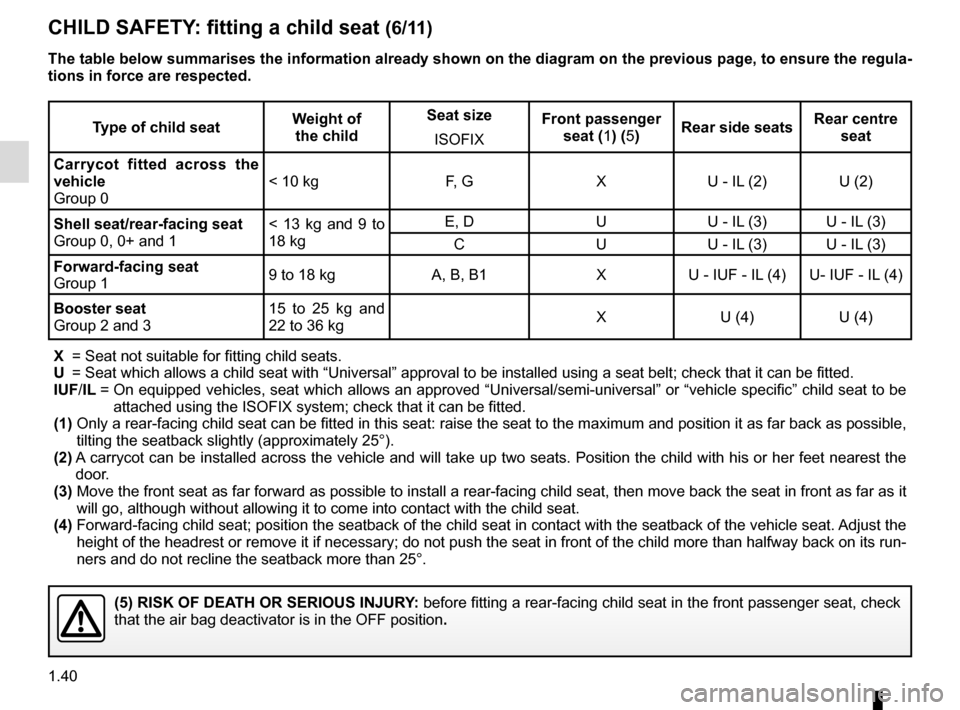
1.40
CHILD SAFETY: fitting a child seat (6/11)
Type of child seatWeight of
the child Seat size
ISOFIX Front passenger
seat (1) (5) Rear side seats Rear centre
seat
Carrycot fitted across the
vehicle
Group 0 < 10 kg F, G X U - IL (2) U (2)
Shell seat/rear-facing seat
Group 0, 0+ and 1 < 13 kg and 9 to
18 kgE, D U U - IL (3) U - IL (3)
C U U - IL (3) U - IL (3)
Forward-facing seat
Group 1 9 to 18 kg A, B, B1 X U - IUF - IL (4) U- IUF - IL (4)
Booster seat
Group 2 and 3 15 to 25 kg and
22 to 36 kg
X U (4) U (4)
X = Seat not suitable for fitting child seats.
U = Seat which allows a child seat with “Universal” approval to be ins\
talled using a seat belt; check that it can be fitted.
IUF/IL = On equipped vehicles, seat which allows an approved “Universal/semi-u\
niversal” or “vehicle specific” child seat to be
attached using the ISOFIX system; check that it can be fitted.
(1) Only a rear-facing child seat can be fitted in this seat: raise the seat\
to the maximum and position it as far back as possible ,
tilting the seatback slightly (approximately 25°).
(2) A carrycot can be installed across the vehicle and will take up two seats\
. Position the child with his or her feet nearest the
door.
(3) Move the front seat as far forward as possible to install a rear-facing \
child seat, then move back the seat in front as far as it
will go, although without allowing it to come into contact with the chil\
d seat.
(4) Forward-facing child seat; position the seatback of the child seat in co\
ntact with the seatback of the vehicle seat. Adjust the
height of the headrest or remove it if necessary; do not push the seat i\
n front of the child more than halfway back on its run-
ners and do not recline the seatback more than 25°.
(5) RISK OF DEATH OR SERIOUS INJURY: before fitting a rear-facing child seat in the front passenger seat, ch\
eck
that the air bag deactivator is in the OFF position .
The table below summarises the information already shown on the diagram \
on the previous page, to ensure the regula-
tions in force are respected.
Page 49 of 270
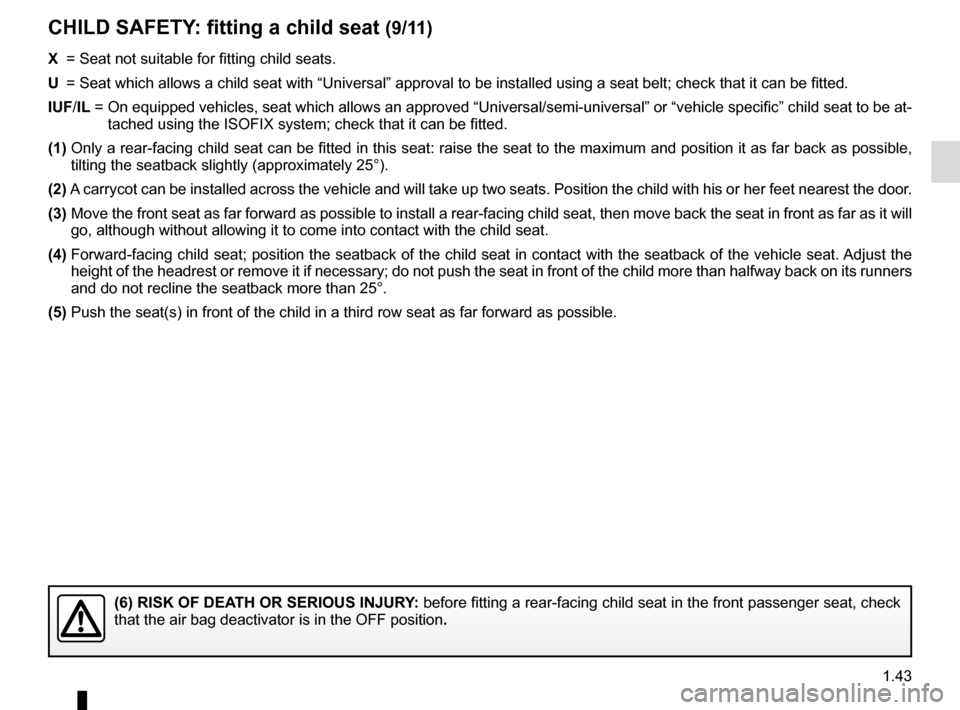
1.43
X = Seat not suitable for fitting child seats.
U = Seat which allows a child seat with “Universal” approval to be ins\
talled using a seat belt; check that it can be fitted.
IUF/IL = On equipped vehicles, seat which allows an approved “Universal/semi-u\
niversal” or “vehicle specific” child seat to be at-
tached using the ISOFIX system; check that it can be fitted.
(1) Only a rear-facing child seat can be fitted in this seat: raise the seat\
to the maximum and position it as far back as possible ,
tilting the seatback slightly (approximately 25°).
(2) A carrycot can be installed across the vehicle and will take up two seats\
. Position the child with his or her feet nearest the door.
(3) Move the front seat as far forward as possible to install a rear-facing \
child seat, then move back the seat in front as far as it will
go, although without allowing it to come into contact with the child sea\
t.
(4) Forward-facing child seat; position the seatback of the child seat in co\
ntact with the seatback of the vehicle seat. Adjust the
height of the headrest or remove it if necessary; do not push the seat i\
n front of the child more than halfway back on its runn ers
and do not recline the seatback more than 25°.
(5) Push the seat(s) in front of the child in a third row seat as far forw\
ard as possible.
(6) RISK OF DEATH OR SERIOUS INJURY: before fitting a rear-facing child seat in the front passenger seat, ch\
eck
that the air bag deactivator is in the OFF position .
CHILD SAFETY: fitting a child seat (9/11)
Page 51 of 270
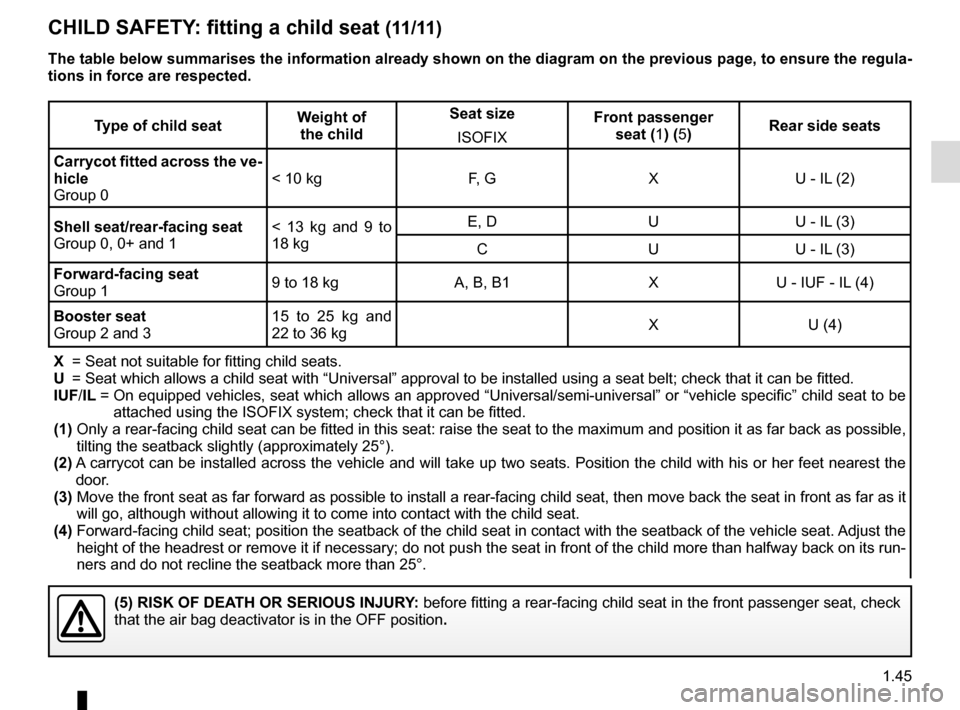
1.45
Type of child seatWeight of
the child Seat size
ISOFIX Front passenger
seat (1) (5) Rear side seats
Carrycot fitted across the ve-
hicle
Group 0 < 10 kg
F, GXU - IL (2)
Shell seat/rear-facing seat
Group 0, 0+ and 1 < 13 kg and 9 to
18 kgE, D
UU - IL (3)
C UU - IL (3)
Forward-facing seat
Group 1 9 to 18 kg
A, B, B1 XU - IUF - IL (4)
Booster seat
Group 2 and 3 15 to 25 kg and
22 to 36 kg
X
U (4)
X = Seat not suitable for fitting child seats.
U = Seat which allows a child seat with “Universal” approval to be ins\
talled using a seat belt; check that it can be fitted.
IUF/IL = On equipped vehicles, seat which allows an approved “Universal/semi-u\
niversal” or “vehicle specific” child seat to be
attached using the ISOFIX system; check that it can be fitted.
(1) Only a rear-facing child seat can be fitted in this seat: raise the seat\
to the maximum and position it as far back as possible ,
tilting the seatback slightly (approximately 25°).
(2) A carrycot can be installed across the vehicle and will take up two seats\
. Position the child with his or her feet nearest the
door.
(3) Move the front seat as far forward as possible to install a rear-facing \
child seat, then move back the seat in front as far as it
will go, although without allowing it to come into contact with the chil\
d seat.
(4) Forward-facing child seat; position the seatback of the child seat in co\
ntact with the seatback of the vehicle seat. Adjust the
height of the headrest or remove it if necessary; do not push the seat i\
n front of the child more than halfway back on its run-
ners and do not recline the seatback more than 25°.
(5) RISK OF DEATH OR SERIOUS INJURY: before fitting a rear-facing child seat in the front passenger seat, ch\
eck
that the air bag deactivator is in the OFF position .
The table below summarises the information already shown on the diagram \
on the previous page, to ensure the regula-
tions in force are respected.
CHILD SAFETY: fitting a child seat (11/11)
Page 143 of 270
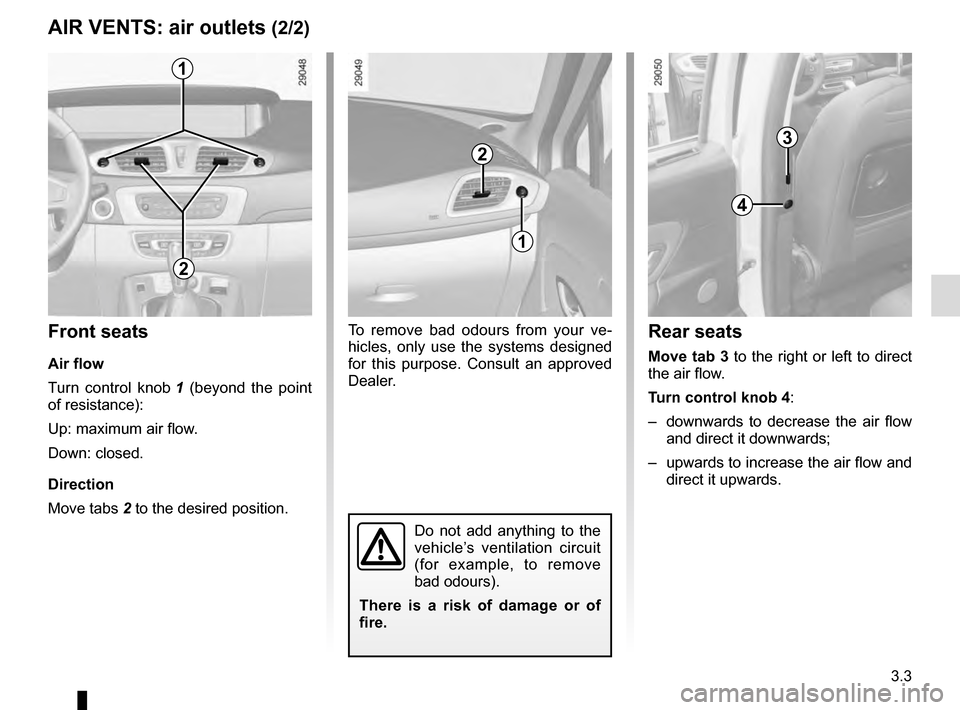
3.3
To remove bad odours from your ve-
hicles, only use the systems designed
for this purpose. Consult an approved
Dealer.
AIR VENTS: air outlets (2/2)
2
1
1
2
Front seats
Air flow
Turn control knob 1 (beyond the point
of resistance):
Up: maximum air flow.
Down: closed.
Direction
Move tabs 2 to the desired position.
Rear seats
Move tab 3 to the right or left to direct
the air flow.
Turn control knob 4 :
– downwards to decrease the air flow and direct it downwards;
– upwards to increase the air flow and direct it upwards.
Do not add anything to the
vehicle’s ventilation circuit
(for example, to remove
bad odours).
There is a risk of damage or of
fire.
4
3
Page 169 of 270

3.29
REAR SEAT FUNCTIONS (2/2)To fit a seat
Attach the hooks 8 to rail 7 marked 9 by
gently lifting the back of the seat.
Tilt the seat as far forwards as possible,
movement B (the handle 6 locks ac-
companied by a locking noise).
Note: it may be necessary to move
the passenger and/or driver’s seats
forwards and to lower the seatback in
order to tilt the seat as far forwards as
possible.
Lower the seat until it locks in place at
floor level.
Check that it is correctly locked.
When fitting side seats, make sure
that the seat belt buckle is inside the
vehicle.
To remove a seat
With the seat folded down, gently lower
it while lifting handle 6.
Release the handle and guide the seat
to the floor.
Remove the seat from the vehicle by lif-
ting it.
Once the rear seats have been re-
moved, ensure that they are rested
on a flat surface so as not to damage
the units under the seats (depen-
ding on the vehicle).
When refitting the seat-
back, make sure it is cor-
rectly locked in place.
If seat covers are fitted ,
make sure these do not prevent the
seatback latch from locking in.
Make sure that the seat belts are
positioned correctly.
Reposition the headrests.
When driving with the seats
folded down: ensure you
check that the seats are
moved fully forward before
folding them down and place the
load as close as possible to prevent
the seats from falling back when ac-
celerating or during sudden braking.
6
B
6
8
7
9